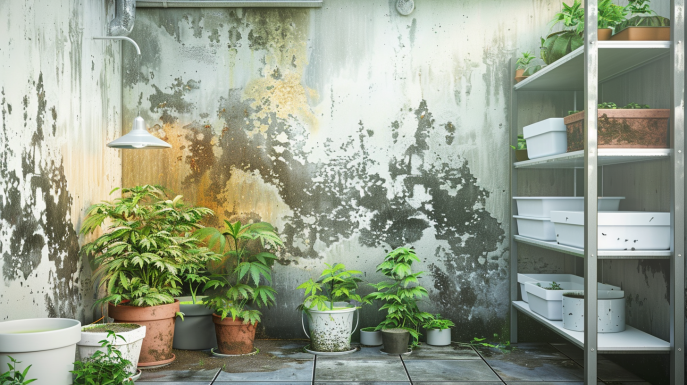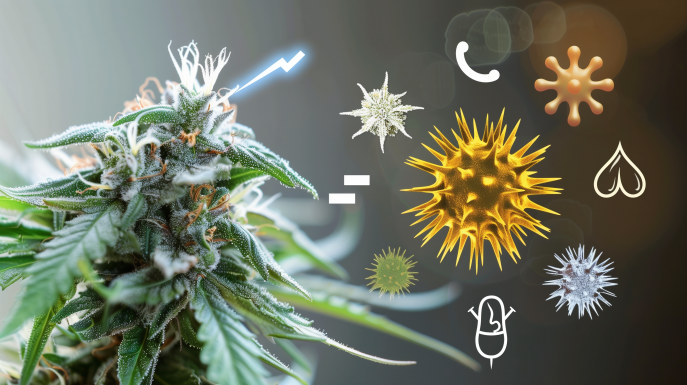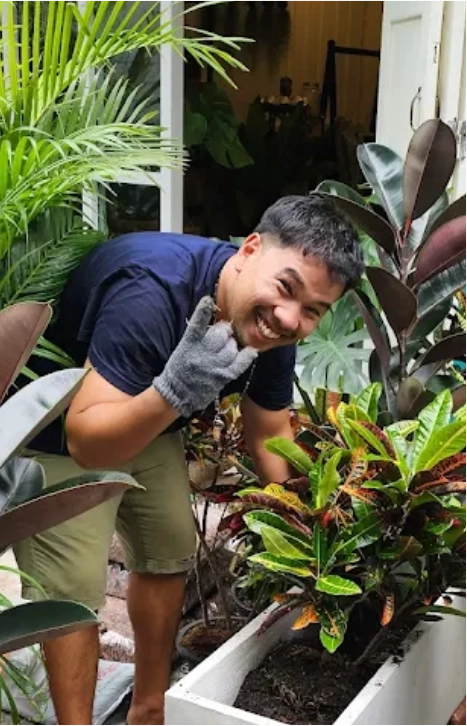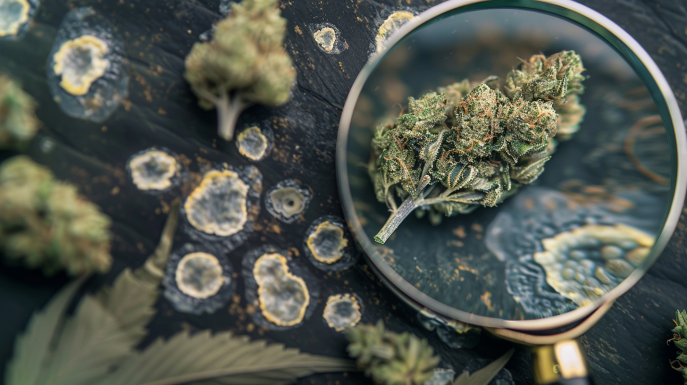We’ve all had that heart-sinking moment when we discover mold has invaded our food or living spaces. But did you know that your cherished weed is not immune to this uninvited guest?
Any of us who value the pleasure of cannabis and worry about the quality of our buds should be aware.
In this comprehensive guide, we’re going to share our knowledge about mold on cannabis. You’ll learn how it forms, how to spot it on your stash, and the risks it presents.
We’ll also offer some practical tips on how to prevent mold formation and explain why we strongly discourage smoking moldy weed.
After all, our mission is to ensure you enjoy your cannabis in the purest form possible.
This topic is close to our hearts, so take the time to read through this guide and become an expert in getting the most out of your cannabis – we promise it’s worth it!
What Exactly is Mold?
Mold is a type of fungus that thrives in damp environments, composed of microscopic spores floating in the air. It can occur during cannabis cultivation or improper storage. Mold can break down organic materials and settle on almost any surface under the right conditions.
Mold can appear on cannabis when the plants are in a humid environment or lack proper ventilation. During storage, mold can develop if the cannabis flowers aren’t dried properly or are kept in a damp container.
Common molds associated with cannabis include Aspergillus, Penicillium, Botrytis (gray mold), and Cladosporium. Aspergillus can cause invasive aspergillosis, a severe form of pneumonia. Penicillium, from which penicillin is derived, shouldn’t be consumed if found on cannabis. Botrytis can infest plants rapidly and cause allergic reactions, while Cladosporium can pose health issues for those with weakened immune systems.
Inspecting cannabis for mold is crucial, as different types of mold pose various health risks but should all be considered dangerous and avoided.
How does mold occur?
The development of mold on cannabis can be facilitated by various conditions. One key factor is high humidity. Mold thrives in damp environments, hence it’s crucial to manage humidity levels in cultivation areas and storage spaces. A relative humidity of 45-55% is optimal to prevent mold growth on cannabis.
Temperature also plays a significant role. Mold growth and proliferation are most effective between 20 and 30 degrees Celsius. Therefore, it’s advisable to maintain the ambient temperature in cultivation and storage areas as stable as possible to deter the growth of mold.
Poor ventilation and hygiene
Inadequate ventilation can stimulate mold growth.
Good air circulation is essential to transport moisture away and secure optimal gas exchange for the plants. Make sure your cultivation or storage area has an efficient ventilation system to prevent mold formation.

Poor hygiene and cleaning can also contribute to mold growth. It’s essential to clean and disinfect cultivation and storage areas regularly to remove mold spores and other harmful microorganisms. Ensure all surfaces, equipment, and tools are clean to minimize the risk of mold formation.
Overwatering and its impact
Mold can also occur due to excessive watering or incorrect irrigation.
Excess water can lead to a build-up of moisture in the cultivation environment, facilitating mold growth. Be careful not to overwater your plants and use an irrigation system that ensures even water distribution.
In summary, the most common causes for mold growth on cannabis are high humidity, uncontrolled temperatures, inadequate ventilation, poor hygiene, and overwatering.
By taking appropriate measures to control these factors, you can effectively avoid mold formation on your cannabis and ensure that your plants remain healthy and free from mold.
Recognizing Mold in Cannabis: Prevention, Identification, and Action
Mold in cannabis can be challenging to spot, especially for inexperienced growers or consumers.
In its early stages, mold can easily be confused with a high concentration of THC as the trichomes also have a white, crystally appearance. To safely identify mold in cannabis, look for the following indicators:
- Unusual dark green or gray-white spots on the surface of the buds
- A white, fuzzy or powdery coating on the leaves and buds
- An altered, rotten or musty aroma that differs from the typical cannabis smell
- An altered texture of the buds that feel mushy or crumbly
Besides visually inspecting the cannabis flowers, one can identify if the marijuana is afflicted by mold by its smell and taste. Moldy weed often has a musty, rotten or foul odor that significantly deviates from the fresh cannabis smell. Such a smell should instantly alert you and prompt you to examine your flowers more closely.
To detect mold in cannabis by smelling and careful observation, follow these steps:
- Smell the flowers: Hold the cannabis flowers in your hand and sniff them. Pay attention to whether they have an unpleasant, musty or rotten smell that could indicate mold.
- Examine the buds carefully: Use a magnifying glass or microscope and observe the buds for signs of mold, like white, gray or green spots that look like a fuzzy or dusty growth. Mold can be hidden both on the surface and inside the buds, hence a thorough examination is required.
- Look out for discolorations and changes in texture: Mold infestation can cause the buds to discolor or have an unusual texture. Notice if the buds appear darker or spotty or whether they are softer and mushier than usual.
By carefully smelling and examining your cannabis flowers, you can detect mold infestation in time and minimize the risk of health issues that arise from smoking moldy weed. It’s always better to play it safe and dispose of suspicious buds rather than consuming them and enduring potential health consequences.
Why Mold on Weed Can Be Dangerous?
Chilling with some weed should be an enjoyable and safe experience, bro. But consuming moldy cannabis is a no-go, man. The health risks are serious and should be avoided at all costs. Here are some of the nasty stuff that can happen when you consume moldy weed:
- Respiratory Issues: When you inhale mold spores, it can lead to respiratory infections and irritations, coughing, wheezing, and shortness of breath. People with pre-existing respiratory diseases like asthma or Chronic Obstructive Pulmonary Disease (COPD) are particularly at risk.
- Allergic Reactions: A lot of people are allergic to mold and smoking moldy weed can trigger allergic reactions such as sneezing, itchy and watery eyes, a stuffed nose, and rashes in sensitive individuals.
- Immune System: Getting high on moldy green can weaken your immune system, increasing the risk of infections especially in people with already weakened immune systems due to chronic illnesses or the use of immunosuppressants.
- Mycotoxins: Mold produces toxic compounds called mycotoxins that can enter your body when you smoke moldy weed. These mycotoxins can cause symptoms ranging from nausea, vomiting, headaches, to even neurological disorders.
- Taste and Enjoyment: Besides all the health risks, moldy weed just tastes and smells gross, dude! It massively spoils the enjoyment of consumption. You might be tempted by the quick high, but the risks and loss of enjoyment far outweigh the short-term benefits.
Given these potential dangers and symptoms, it’s wiser to stay away from moldy cannabis and stick to healthy, mold-free buds. Your health and enjoyment of cannabis should always come first, man.

It’s better to play it safe and ditch suspicious buds than consume them and risk potential health effects.
How to Prevent Mold on Cannabis?
To avoid the bummer of finding mold on your weed, you need to control the factors that encourage mold growth. Here are some pro tips to prevent mold in your cannabis cultivation:
- Ensure proper ventilation in your grow room to reduce humidity and prevent mold formation.
- Keep a check on the temperature and humidity, and maintain them within the recommended ranges for cannabis cultivation (between 20-28°C and 40-50% humidity).
- Avoid overwatering your plants as this can lead to increased moisture and promote mold growth.
- Regularly remove dead or diseased plant parts to minimize the spread of mold.
- Make sure there are no wet plant parts in direct contact with the buds as this can encourage mold formation.
- Harvest and dry your cannabis carefully to avoid mold during the drying process.
Why We Advise Against Smoking Moldy Weed
We get it, the thought of smoking moldy cannabis might cross your mind especially if you’ve spent your hard-earned cash on it and it’s not easy to throw away.
But seriously, dude, we strongly discourage consuming moldy weed. The health impacts can be severe and the potential risks just aren’t worth it.
When you smoke moldy weed, you’re inhaling mold spores directly into your lungs. This can lead to a bunch of health problems like allergic reactions, respiratory infections, and worsening of existing respiratory diseases like asthma or COPD.
Folks with weakened immune systems, like the elderly or those undergoing chemotherapy, are even more vulnerable to the negative effects of mold spores.
The health impacts can be serious and cause long-term damage in some cases. One of the most dangerous types of mold that can be found on cannabis is Aspergillus.
This type of mold can cause a severe form of pneumonia known as invasive aspergillosis, which can even be fatal in some cases.
Apart from the health risks, the taste and smell of moldy weed is just unpleasant and unappetizing, man. You’ll probably notice a musty, rotten taste that ruins the smoking experience. It’s better to play it safe and discard moldy weed than to smoke it and potentially risk your health.
Even if it might be super annoying to throw away moldy weed, your health should always come first. It’s better to wait for a safer source of cannabis or take steps to prevent future mold contamination than to risk your health by consuming moldy weed.
Commonly Asked Queries
Ever wondered if it’s okay to consume moldy cannabis in any form? Now, let’s get this straight: Smoking or consuming moldy cannabis in any other way is strongly discouraged. Why? It could lead to health complications such as respiratory illnesses, allergic reactions, and worsening of pre-existing health conditions. Plus, mold dramatically interferes with the flavor and aroma of the cannabis.
How do I spot mold on my cannabis?
Mold on cannabis can often be spotted by an unusual discoloration on the plant – think dark green or gray-white spots. Moreover, a furry or powdered substance on the surface could also be a sign.
The smell of moldy cannabis usually tends to be stale and musty. Use all your senses like sight, smell, and touch to detect mold on cannabis. Tools like a pocket microscope or a black light lamp can come in handy for identifying mold.
Preventing mold in my cannabis cultivation – How?
To prevent mold from developing in your cannabis cultivation, it’s crucial to manage factors that favor mold growth.
This includes ensuring proper ventilation, regulating temperature and humidity, avoiding overwatering the plants, regularly removing dead or diseased plant parts, and ensuring that wet plant parts don’t directly come in contact with the buds.
The aftermath of accidentally consuming moldy marijuana – What happens?
Accidentally consuming moldy marijuana could potentially lead to health issues like respiratory complaints, allergic reactions, or worsening of pre-existing health conditions.
The specific impact depends on the amount of consumed mold and your personal health condition. If you notice symptoms after accidentally consuming moldy marijuana, it’s advised to consult a doctor.
What should I do with moldy cannabis if I can’t smoke or consume it?
The best course of action with moldy cannabis is disposal, ensuring you avoid any health risks. In some instances, if the mold contamination is light, the cannabis could probably be salvaged by heating it around 150° Celsius for about 10 to 20 minutes or by bathing the buds in a hydrogen peroxide-water mixture.
However, in case of heavy mold infestation, the cannabis should be disposed of.
Be sure to wear appropriate protection like gloves and breathing masks to prevent exposure to mold spores while disposing of moldy cannabis.
Can moldy cannabis be “rescued”?
In some instances where the cannabis is lightly infested with mold, it may be possible to salvage it by heating or bathing in a hydrogen peroxide-water mixture as mentioned above.
However, these methods don’t guarantee complete removal of mold spores and there’s still a certain health risk involved.
With heavy mold infestation, the cannabis should be disposed of as consumption isn’t safe.
Preventing purchase of moldy cannabis – How do I ensure?
When buying cannabis, look for signs of mold like unusual discolorations, furry or powdered substances, and stale smell. Ensure you’re buying from trustworthy sources who prioritize quality and safety.
Be especially cautious with riffraff as some growers or sellers may try to resell moldy hemp flowers to avoid losses. If in doubt about the quality of the cannabis, it’s best not to consume it and look for a safer source instead.
The risks of using mold-infested cannabis in edibles – What are they?
A question often asked is whether it’s okay to use moldy cannabis in the form of tea, cake, or other edibles.
We understand that you’re looking for ways to use your cannabis despite mold infestation, especially if you’ve invested time and money into it.
Regarding tea, cake, and other forms of use: Even if you process moldy cannabis in food, the risks remain. Heating may kill some types of mold, but the toxic substances they produce, like mycotoxins, often stay intact and can’t simply be “cooked” or “baked”.
These toxins can enter your body upon consumption and cause health problems. It’s also important to remember that mold doesn’t just sit on the surface of cannabis.
It can penetrate deep into the plant, and even if you remove visible mold, there could still be spores and toxins that you can’t see.
We know it’s hard to dispose of cannabis, especially when you feel it could still be put to use. But health should always come first. It’s safer to dispose of moldy cannabis instead of risking consumption and possible health issues.
Wrap Up
Mold on cannabis poses health risks and can impair the taste, smell, and quality of your stash.
By controlling factors that favor mold growth and watching out for signs of mold, you can keep your cannabis cultivation healthy and free from mold.
Refrain from smoking moldy marijuana to safeguard your wellbeing and ensure a pleasant cannabis experience.
Look for unusual dark green or gray-white spots, a white fuzzy coating, and a musty, rotten smell. Use a magnifying glass for a thorough inspection.
Consuming moldy weed can cause respiratory issues, allergic reactions, and weakened immune systems due to mold spores and mycotoxins.
Ensure proper ventilation, control temperature and humidity, avoid overwatering, and maintain cleanliness in your grow area.
It’s best to dispose of moldy cannabis to avoid health risks. In some cases, light mold contamination can be treated with heat or hydrogen peroxide, but heavy infestation should be discarded.
No, even cooking or baking won’t remove mycotoxins. It’s safer to dispose of moldy cannabis to avoid potential health issues.
You may experience respiratory issues, allergic reactions, or worsen pre-existing conditions. Consult a doctor if you notice symptoms.









